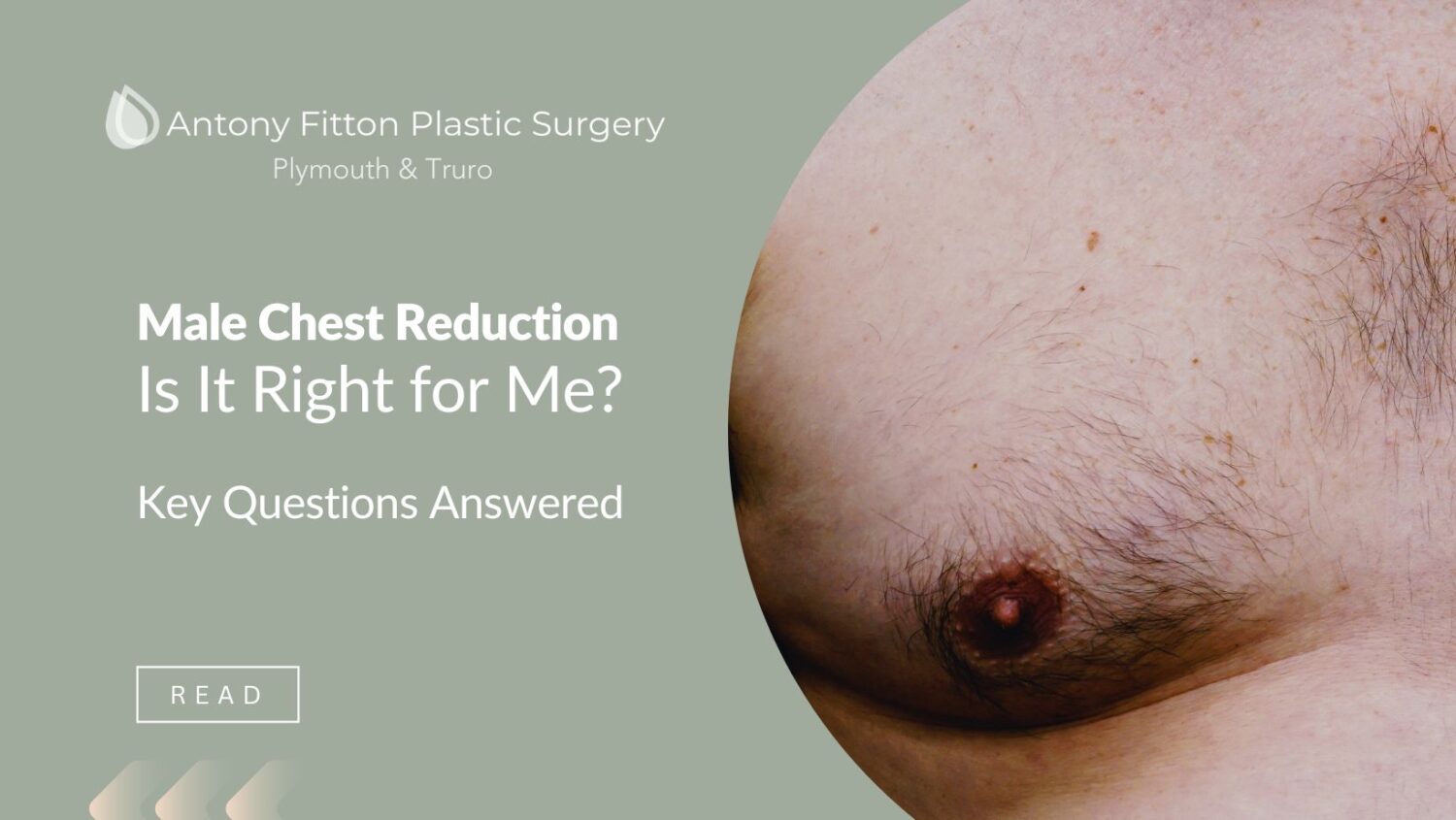
Is Male Chest Reduction Right for Me? Key Questions Answered
Male chest reduction, often known as gynecomastia surgery or male breast reduction, is becoming increasingly popular among men seeking cosmetic surgery to address excess breast tissue.
This condition, affecting millions worldwide, can cause emotional distress and physical discomfort. Many men wonder if undergoing a chest reduction is right for them. By exploring common concerns and queries about the chest reduction procedure, you can determine if this life-altering surgery aligns with your personal goals and needs.
What is Male Chest Reduction?
Male chest reduction is a surgical procedure typically aimed at reducing the size of enlarged male breasts, a condition medically known as gynecomastia. This condition involves excess glandular tissue and fat, and sometimes skin, in the chest area, leading to a feminised appearance of the chest. The reduction process usually involves the removal of this tissue through surgical intervention. Liposuction may also be utilised to remove excess fatty tissue and achieve a more contoured chest appearance.
The objective of male chest reduction is not solely aesthetic. It also aims to alleviate any physical discomfort or emotional distress associated with the condition. Performed by a qualified surgeon like Mr Fitton, the procedure is generally considered safe and can significantly enhance the quality of life for those affected by gynecomastia.
Who Typically Seeks Male Chest Reduction?
Men of various ages may seek male chest reduction for different reasons. Adolescents going through hormonal changes during puberty can develop gynecomastia, though it often resolves with time. However, if the condition persists into adulthood, it can become a source of embarrassment or discomfort for many men.
Those who are overweight might also experience a similar condition known as pseudogynecomastia, where the breast enlargement is primarily due to fatty tissue. Men who suffer from these conditions often turn to male chest reduction as a solution to regain confidence and comfort in their physical appearance. Additionally, bodybuilders and athletes who may have an imbalance in muscle development or unrealistic fat deposits could also seek chest reduction for symmetry and visual appeal.
The Difference Between Gynecomastia and Pseudogynecomastia
It is crucial to understand the difference between gynecomastia and pseudogynecomastia to determine the right course of action. Gynecomastia involves the proliferation of glandular breast tissue, while pseudogynecomastia is a result of excess fatty tissue with minimal glandular involvement.
Distinguishing between the two is essential because the surgical approach may vary. For gynecomastia, excision of the glandular tissue is often necessary, while pseudogynecomastia may be effectively treated with liposuction. A thorough evaluation by a skilled cosmetic surgeon is necessary to diagnose the predominant cause and decide on the most appropriate treatment.
Reasons to Consider Male Chest Reduction
Physical Discomfort and Health Concerns
Enlarged male breasts can lead to physical discomfort, particularly during physical activities. Men with gynecomastia or pseudogynecomastia may experience chafing, skin irritation, or even back pain due to the added weight and altered posture. In some cases, the condition could also lead to infections in the skin folds.
Addressing these physical discomforts through male chest reduction can lead to better posture, increased mobility, and an overall enhanced quality of life. Additionally, removing excess tissue can reduce the chances of these health issues and improve general well-being.
Psychological and Emotional Benefits
The psychological impact of gynecomastia or pseudogynecomastia can be profound. Men suffering from these conditions often experience lowered self-esteem, anxiety, or depression due to negative body image. It can also lead to social withdrawal, avoidance of certain situations like swimming or exercising in public gyms, and even impact intimate relationships.
The emotional relief and boosted self-confidence following male chest reduction surgery are significant. Many men report a renewed sense of self and improved mental health, allowing them to engage more fully in social and personal activities without the nagging worry of judgement or embarrassment.
Enhancing Physical Appearance
Cosmetic motivations are a legitimate reason to consider male chest reduction. For many, achieving a masculine and contoured chest contributes significantly to a positive self-image. The procedure can help men fit better into clothing and feel more comfortable without the need to disguise or hide their chest with baggy clothing.
Whether seeking a more toned appearance or correcting a congenital issue, male chest reduction can bring about the desired transformation. It allows individuals to embrace their bodies with confidence and pride in their physical appearance. Ultimately, investing in this procedure can serve as a step towards self-improvement and personal satisfaction.
The Male Chest Reduction Procedure
Male chest reduction involves removing excess glandular tissue, fat, and sometimes skin, to achieve a flatter, more masculine chest contour.
Types of Chest Reduction Surgeries
There are various surgical techniques used for male chest reduction, and the choice depends on the individual’s specific needs and the severity of gynecomastia. The most common types include:
– Liposuction: Ideal for cases where excess fatty tissue predominates, liposuction involves the removal of fat through small incisions. It is less invasive and often leads to quicker recovery times.
– Excision: This method is employed when there is a significant amount of glandular tissue or excess skin. It involves making incisions around the areola or along the natural creases of the chest to remove the tissue and possibly reposition the nipple.
– Combination Approach: In many cases, a combination of liposuction and excision is used to achieve the best results, especially when both fat and glandular tissue are present.
What to Expect During the Surgery
Male breast reduction surgery typically takes one to three hours and is usually performed under general anaesthesia. The steps involved generally include:
1. Anaesthesia: You will receive medications to make you comfortable during the surgical procedure.
2. Incision Making: Mr Fitton will make incisions based on the surgical technique chosen, either liposuction, excision, or both.
3. Tissue Removal: Excess fat and glandular tissue are then removed, and any necessary adjustments to the skin or nipple-areola complex are made.
4. Closing Incisions: Once the tissue is removed, the incisions are closed with sutures. Drains may be placed to ease swelling and help the healing process.
Recovery and Aftercare
Post-procedure, the recovery phase is crucial for achieving the desired outcomes. Here’s what you can generally expect:
– Immediate Aftercare: Patients are usually able to return home the same day. They may experience some discomfort, swelling, and bruising, which is normal and should gradually subside over a few weeks.
– Dressings and Bandages: Dressings will be applied to the incisions, and an elastic bandage or support garment is often recommended to minimise swelling and support the new chest contour.
– Physical Activity: Patients are advised to avoid strenuous physical activity, heavy lifting, and exercising for several weeks post-surgery. Regular follow-up appointments with the surgeon are important to monitor your recovery progress.
– Lifestyle Adjustments: Maintaining a healthy lifestyle and stable weight is recommended to sustain the aesthetic results of the surgery.
Is Male Chest Reduction Right for You?
Deciding to undergo male chest reduction is a significant decision that requires careful consideration of personal motivations, medical suitability, and desired outcomes.
Evaluating Personal Goals and Expectations
Understanding your personal motivations and realistic expectations is crucial:
– Personal Goals: Reflect on why you want the surgery. Are you seeking relief from physical discomfort, or is the emotional and psychological impact of gynecomastia the primary driver?
– Realistic Expectations: Have a clear understanding of the potential outcomes. While surgery can significantly improve your chest contour, it’s essential to have reasonable expectations regarding the extent of improvement.
Medical Eligibility Criteria
To determine if you’re a suitable candidate, there are certain criteria to consider:
– Age and Development: Generally, candidates are at least 18 years old and have stable breast development.
– Health Status: Good overall health is important. Chronic conditions such as heart disease or diabetes should be well-managed.
– Weight Stability: Candidates should ideally be within their medically approved weight range and maintain stable weight beforehand.
Consulting with a Qualified Surgeon
The final, and perhaps most critical step, is consulting with a qualified cosmetic surgeon:
– Experience: Ensure the surgeon is board-certified and experienced in performing male breast reduction surgeries.
Antony Fitton qualified at the Royal London Hospital in 1989 with a distinction in Surgery. He holds an MB, BS(Hons)., MD., FRCS(eng). and FRCS(plast) (Fellowship at the Royal College of Surgeons). He is a member of BAPRAS (British Association for Plastic, Reconstructive and Aesthetic Surgeons), BAAPS (British Association for Aesthetic Plastic Surgeons), and BSSH (British Society for Surgery of the Hand).
– Discussion: Have an open discussion about your concerns, ask questions, and discuss the potential risks and benefits. A reputable surgeon will provide a comprehensive assessment of your suitability for the procedure.
We can offer both consultations and treatments at either the Nuffield Health Hospital, Plymouth or the Duchy Hospital, Truro. Mr Fitton also consults by internet video conferencing and, if preferred, an initial consultation can be arranged in this way.
– Second Opinions: Do not hesitate to seek a second opinion as this can provide additional insights and boost your confidence in your decision-making process.
Embarking on the journey to male chest reduction requires thorough research, introspection, and consultation with professionals to ensure it aligns with your personal needs and health profile.
Is male chest reduction permanent?
Male chest reduction, or gynecomastia surgery, offers long-lasting results. However, to maintain these outcomes, it is crucial to lead a healthy lifestyle. Fluctuations in weight, certain medications, or hormonal changes can affect the chest's appearance post-surgery.
How long is the recovery period?
Recovery from male breast reduction typically takes a few weeks. Patients are advised to avoid strenuous activities and to follow their surgeon's guidelines to ensure proper healing. Most individuals can resume normal activities within a month.
Are there any risks associated with the surgery?
As with any cosmetic surgery, there are inherent risks, such as infection, bleeding, or scarring. Choosing a qualified and experienced surgeon can minimise these risks significantly.
Will health insurance cover this procedure?
Coverage for gynecomastia surgery varies. Some insurance policies may cover the procedure if it is deemed medically necessary. It's important to consult with your insurance provider to understand your specific coverage.
Can diet and exercise substitute for surgery?
While diet and exercise might reduce overall body fat, they may not effectively target the breast tissue causing gynecomastia. Surgery is often the most effective solution for achieving a flatter chest appearance in persistent cases.
Understanding these nuances can help you make informed decisions and potentially schedule your desired procedure more effectively. Stay proactive in communication with Antony Fitton Plastic Surgery to expedite the process.
Plastic surgery can be a life-changing decision, offering both cosmetic and functional benefits.
However, it is crucial to have accurate information and realistic expectations. Consulting with a certified and experienced plastic surgeon is the best course of action to ensure you receive personalised advice and clear answers to any queries.
– Educate Yourself: Research procedures thoroughly.
– Prepare for Recovery: Understand the time and effort needed for healing.
– Prioritise Your Safety: Choose reputable clinics and experienced professionals.
Ultimately, informed decision-making plays a vital role in achieving satisfactory results in any cosmetic procedure.
For a no-obligation quote
For a no-obligation quote, tailored specifically to you, please book in for your consultation with Mr Fitton. Your requirements will be discussed in full confidence in a friendly and relaxed atmosphere.
Following your consultation, the price you are quoted includes everything and there are no extra or hidden costs. Advice, treatment and aftercare are all part of our package to ensure your experience is positive from beginning to end.

About your Plastic Surgeon: Mr Antony Fitton
MB, BS(hons)., MD., FRCS(eng)., FRCS(plast).
Mr Antony Fitton qualified at the Royal London Hospital in 1989 with distinction in Surgery. He holds an MB, BS(Hons)., MD., FRCS(eng). and FRCS(plast). (Fellowship at the Royal College of Surgeons).
He is a member of BAPRAS (British Association for Plastic, Reconstructive and Aesthetic Surgeons), BAAPS (British Association for Aesthetic Plastic Surgeons), and BSSH (British Society for Surgery of the Hand).
Mr Fitton has received the Paton & Masser Award and the CM Matthews Award from the Royal College of Surgeons of England for his research in nerve injury.
Mr Fitton is licensed as a Plastic and Reconstructive Surgeon by the GMC.

- 0% Finance Available
- Consultations and treatments are available at either the Nuffield Health Hospital, Plymouth or the Duchy Hospital, Truro
- Care Quality Commission Regulated
- GMC Specialist Registered Surgeon
- BAPRAS, BAAPS and BSSH member
- Registered MD
Life-changing result
"I just wanted to thank you (and your team) for the life-changing result of my top surgery. This will provide me with the freedom that I’m excited to enjoy, including being able to go swimming and actually staying cool in summer! All jokes aside, you have helped to mark a new chapter in my life, for which I am incredibly grateful… ALL the best."
Our appearance has an impact on how others perceive us. We are experts in creating an improved version of you. You can click on the procedure below for more information.
Body surgery (or contouring) can involve all or one of the following, with a prime focus on areas such as the buttocks, tummy, thighs, arms, and breasts. Click on the links below for more information.
There are several different types of hand surgery but all aim to restore functionality while making the hand look as normal as possible. Click on the links below for more information.

Is Male Chest Reduction Right for Me? Key Questions Answered
Is Male Chest Reduction Right for You? This blog answers crucial questions on gynecomastia surgery s

How to Get Plastic Surgery Sooner | Advice from Antony Fitton
Tired of the long NHS waiting times for plastic surgery? Discover how you can access private surgery

Where are Facelift Scars?
Discover where facelift scars are typically located and tips for minimising visibility during recove








